UTS2105 Singapore as “Model” City? is a Senior Seminar offered by Dr Margaret Tan once every few semesters. The seminar invites students to critically engage with the seen and unseen aspects of Singapore’s urban fabric, and “explore what is at stake in meeting Singapore’s ambition within its borders and beyond” [1]. A significant portion of the module’s coursework is dedicated to a public space intervention project with the aim of renegotiating how a site is viewed or treated. Chee Meng, a Year 3 Tembusu alumnus, reflects on the process of executing the project with their teammate Andrew, as well as the subsequent journey the project led them on after its completion.
The Pursuit of 
What do we want in our lives? Money, perhaps? Maybe love? Or maybe, some would answer more broadly, that they’d want to be happy?
One year ago, when tasked to design a public space intervention in UTown for a Senior Seminar module, Andrew and I opened our proposal by posing the above questions. We wanted to engage with an issue dear to all of us – the enigma that is happiness, and our perpetual pursuit of it. One year since, happiness to me remains ever amorphous and ambiguous.
From the beginning of our ideation process, we established that we had to introduce something culturally relevant that engaged the public and the site, but also questioned, challenged, or critiqued popular or mainstream thought. Sharing the wood laminate table in one of our Tembusu rooms after a particularly vexing day of class, we let our spiralling emotions guide the discussion. You know the drill – you’re realising how many things are on your to-do list, and the next thing you know, you’re questioning why you opted for a university education in the first place. (If you, in fact, don’t know the drill, I hope you never do.) In our case, why did we choose to study architecture in the first place? The specifics are different, but probing deeper, and repeatedly asking more whys, we landed on very similar answers. We liked creating and on the whole, we gained fulfillment through our education. More generally, higher education is typically framed as a means to employment. We realised that our aspirations and actions are closely tied to the concept of happiness. Everyone wants different things. But, ultimately, we believe everyone wants to be happy. We grab drinks with friends. We hole up in our rooms to chase that grade. We seek out the best internships over the holidays. We pay to stay on campus.
How were we to represent these myriad demands and desires? Andrew and I settled on the use of symbols. In some ways, symbols are overt in meaning. We all understand ![]() represents money and wealth. Yet symbols also leave a lot of room for interpretation – money might connote greed and evil, but it could also suggest income or financial stability. These associated ideas themselves are also inherently subjective. Is wanting money greedy? Is being greedy necessarily evil? How much is enough income? Andrew and I quickly recognised
represents money and wealth. Yet symbols also leave a lot of room for interpretation – money might connote greed and evil, but it could also suggest income or financial stability. These associated ideas themselves are also inherently subjective. Is wanting money greedy? Is being greedy necessarily evil? How much is enough income? Andrew and I quickly recognised  as the chief reasons we set out chasing our aspirations. While we coined the moniker “cash love clout” for the project, where possible, we referenced the project with the symbols alone to avoid prompting others with specific interpretations of the symbols.
as the chief reasons we set out chasing our aspirations. While we coined the moniker “cash love clout” for the project, where possible, we referenced the project with the symbols alone to avoid prompting others with specific interpretations of the symbols.
To represent the three symbols as the core facets of the amalgamation that is happiness, we wanted to convey that the three were part of the same thing, and in some ways, not so different from each other. Inspired by anamorphic displays and sculptures, we eventually decided to employ the technique in our intervention. We designed the intervention as a sculpture with a form that would appear as the three symbols from three different vantage points in UTown. From the entrance of UTown Residences, the intervention would appear as a dollar sign, as shown in the photograph below. As viewers moved to Starbucks, the work would appear to melt and shift, resolving into a trophy when they arrived: the trophy symbol in the photograph. Finally, the work would also take on the form of a heart symbol from FoodClique. We hoped that viewers would initially encounter the work as a strange shapeless blob, but through the time they spend and activities they partake in UTown, like grabbing a meal, studying at Starbucks, or heading for their rooms in one of the residences, they would encounter one or more of the three symbols, and be curious to approach and engage with it.

A diagram illustrating vantage points at which particular symbols would manifest.

The ambiguous form of the intervention when not viewed from one of the three main vantage points.

Finding ![]() from UTR.
from UTR.

Seeking ![]() at Food Clique.
at Food Clique.

Chasing ![]() at Starbucks.
at Starbucks.

A narrative collage of our intervention.
Inspired by the hedonism we often observed in the public lives of others, we arranged the above collage to guide how we designed the intervention. Wealth, socialising, social media engagement, infatuation, and so on are set in a familiar context (UTown Green and Starbucks) and made to seem unnatural through the haphazard arrangement of the collage, the forced quality stock images often have, and the uncanny sheen of the digitally-generated renderings of UTown. We aimed to manifest this same quality of an uncanny utopia and a veneer of bliss on the surface through the intervention. Viewers first see the three signs and symbols, which are usually seen in a digital or textual medium, physically built into reality through different perspectives on the sculpture. That a plywood sculpture with shifting images of  are suddenly made larger than life invokes wariness and curiosity, and sets the stage for viewers to dig deeper into the concept of happiness beyond the surface.
are suddenly made larger than life invokes wariness and curiosity, and sets the stage for viewers to dig deeper into the concept of happiness beyond the surface.
If viewers were curious enough to investigate beyond the broad notions of happiness purveyed by the vagueness of the symbols, we wanted to offer them more concrete ideas to latch on to. We employed similar anamorphic projection to create quotes that materialised from different angles when viewers searched for them up close. We obtained these quotes from a variety of sources – some we got from talking to friends:
- A RIGOROUS AND FULFILLING ACADEMIC EXPERIENCE
- TIME TO RELAX AND SPEND QUALITY TIME WITH MY FRIENDS
- KEEP FIT AND STAY IN TOUCH WITH MUSIC
Some enlightening quotes came from trawling the university forum on Reddit:
- I ENVY THOSE WHO ARE ABLE TO FIND WHAT THEY LIKE TO DO
- CURIOUS BUT WHAT’S CONSIDERED A DECENT GRADE FOR CS1010? LIKE A B+?
- NOW THAT I HAVE WHAT I WANTED, WHY AM I STILL FEELING LIKE CRAP? I SHOULD BE HAPPY. BUT I AM NOT. I DON’T DESERVE THIS. I AM A FRAUD.
- I FEEL IMMENSELY BLESSED WITH SOMEONE WHO LOVES ME SO SELFLESSLY EVEN THOUGH WE ONLY GET TO SPEND THE WEEKENDS TOGETHER.
However, my personal favourites come from a few relevant events at the time. We referenced the Aphrodite Project, an annual matchmaking event that uses psychology research and a matching algorithm to pair its participants with each other.
- MEET YOUR IDEAL DATE. 20 MINUTES. ONE FINAL MATCH. BUILT ON PSYCHOLOGY & AN ECONOMICS NOBEL PRIZE ALGORITHM.
We also memorialised the announcement of the first-ever NUS Well-Being Day:
- I AM PLEASED TO DESIGNATE FRIDAY, 5 NOVEMBER 2021 AS NUS WELL-BEING DAY WHERE ALL STAFF AND STUDENTS CAN TAKE A WELL-DESERVED BREAK FOR A DAY, TO REST AND RE-ENERGISE.
The quotes showcase the good, bad, and ugly sides of happiness and critique the pursuit of our aspirations. They invite viewers to compare their desires with that of others and question the extent that our desires are internally and externally motivated. Why do I want the things I do? How are some people so sure of what they want? Why should the aspirations of others influence mine?
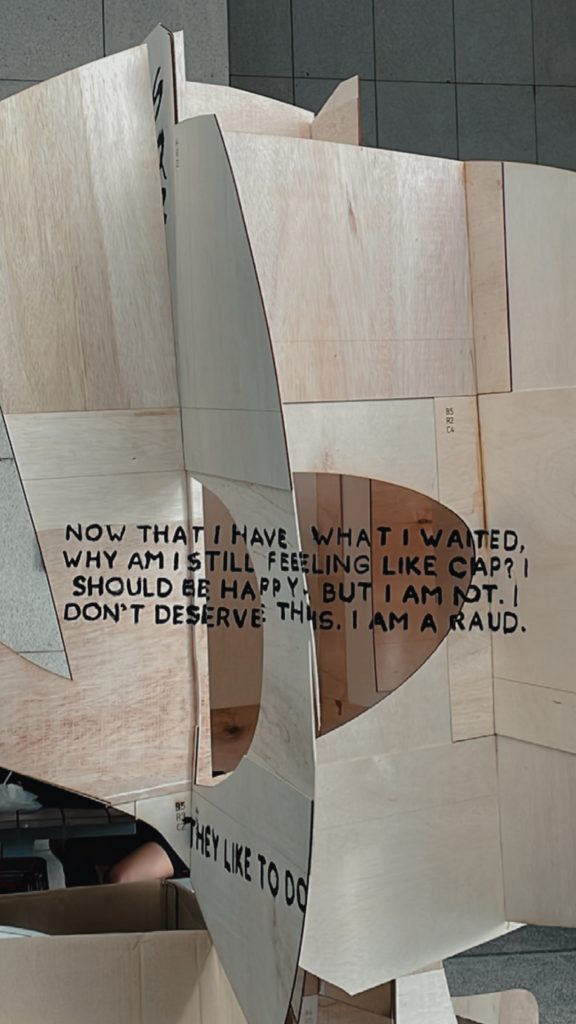
Impostor syndrome.

When viewed from most angles, words from various quotes evocative of our desires mesh together.
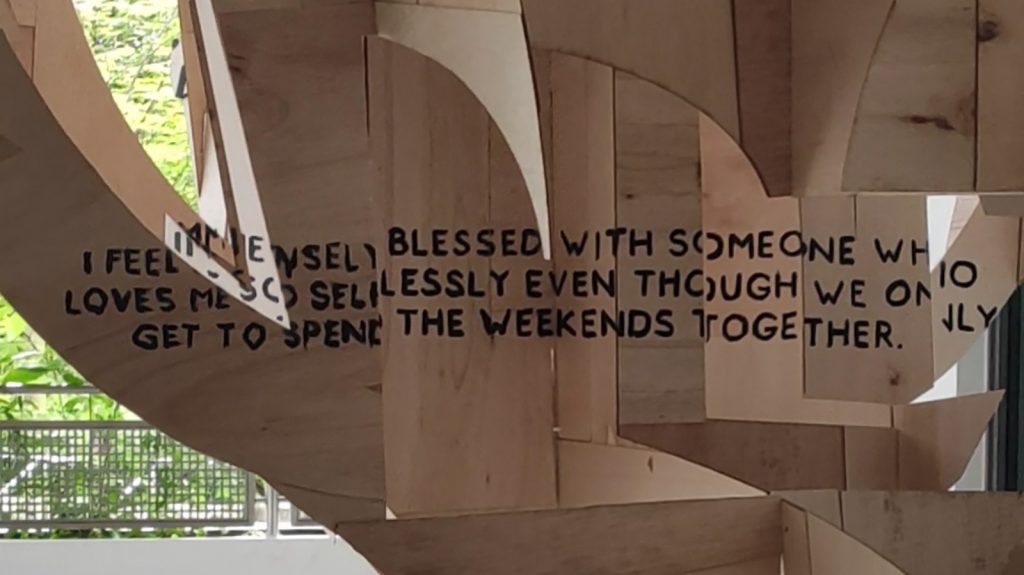
A healthy relationship.
The lead-up to the finished structure was taxing, to say the least. After some days of staking out at the school’s laser cutters, we managed to prepare the puzzle pieces that would form the whole.
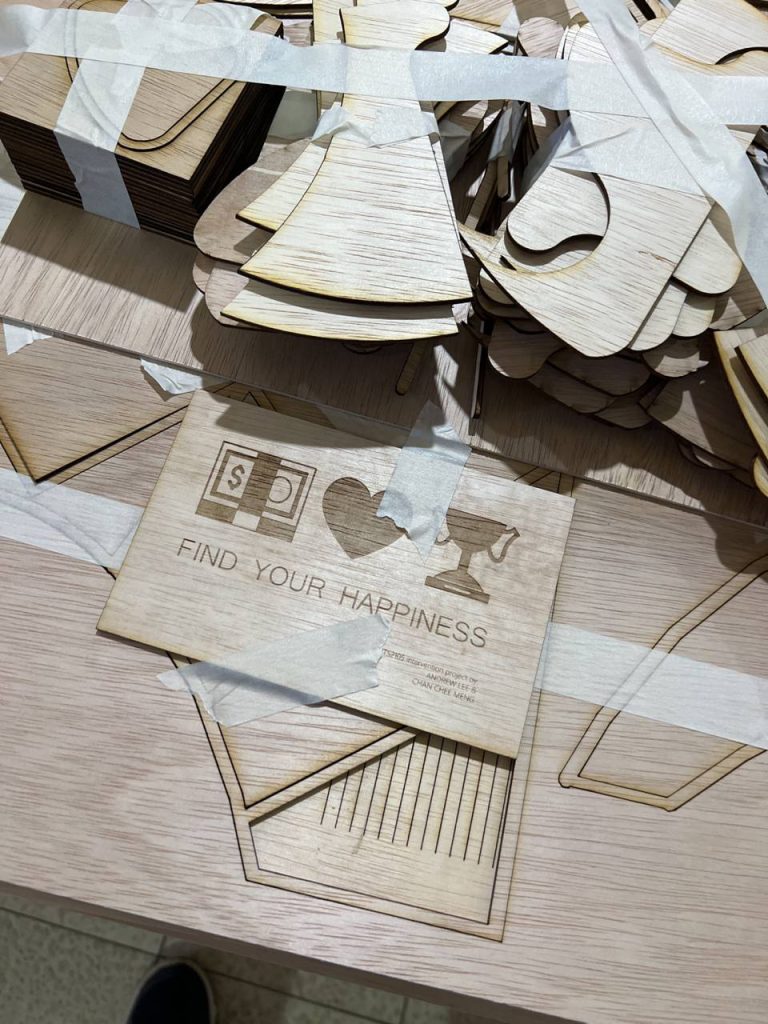
The label for the intervention sitting atop many, many layers of plywood pieces.
It became clear we had stretched ourselves too thin when the assembly extended past the planned period of one night, into the next night, and so on. We eventually took three nights to cobble the behemoth together with super glue and rapidly deteriorating determination. By the second night, we had come full circle – just like how the project had started, we started to question the decisions that had led to us grasping with plywood sheets outside the college entrance in the small hours. Why were we doing this? Was it for the grades? Did this make us happy?
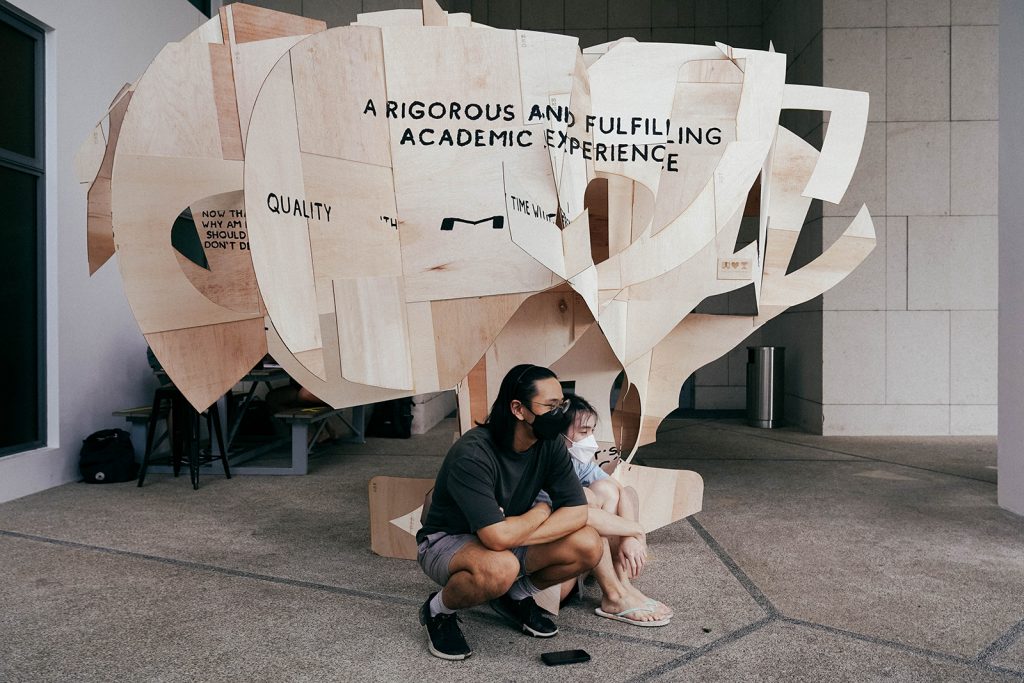
Our faces seem to contradict the quote hovering above us.
The apparent precarity of the structure might seem glaring in the above photo, and precarious it was. We felt the pieces flexing as our imperfect hands combined them together, saw the structure listing to one side as it grew taller, and noticed it faintly swaying in the wind. Our growing doubt was somewhat alleviated when the structure stood after putting the last piece in place.

“Look at these two losers trying to mend their happiness.” A quote from a video of us making touch ups right after installation.
We feared the structure would collapse, so much so that we kept going back to UTown Green periodically throughout the day to check on it. Yet as the shadows grew longer, the structure stayed, gently swaying in the breeze.
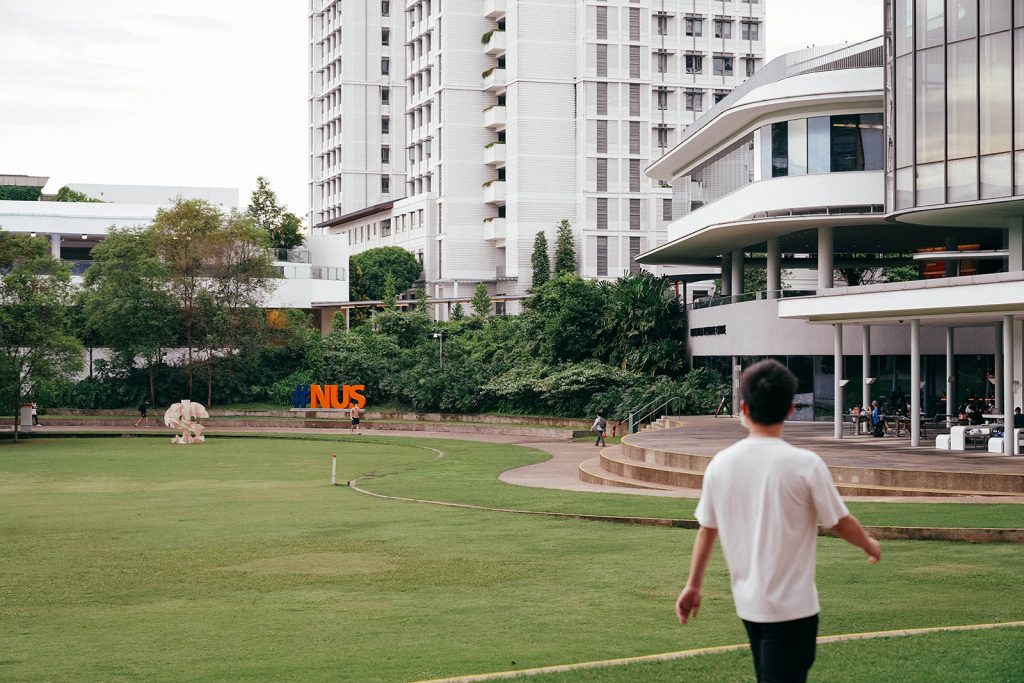
Spotting ![]() from far away…
from far away…

And going closer in search of it.
The structure prevailed late into the night, and prompted by a gentle drizzle, I went down to check on it one last time before turning in for the night.
Famous last words in an exchange between Andrew and me.
I woke up the next morning to my phone flooded with messages. The project had garnered significant attention from its construction to installation, and I already knew what had happened when I saw the stream of notifications.
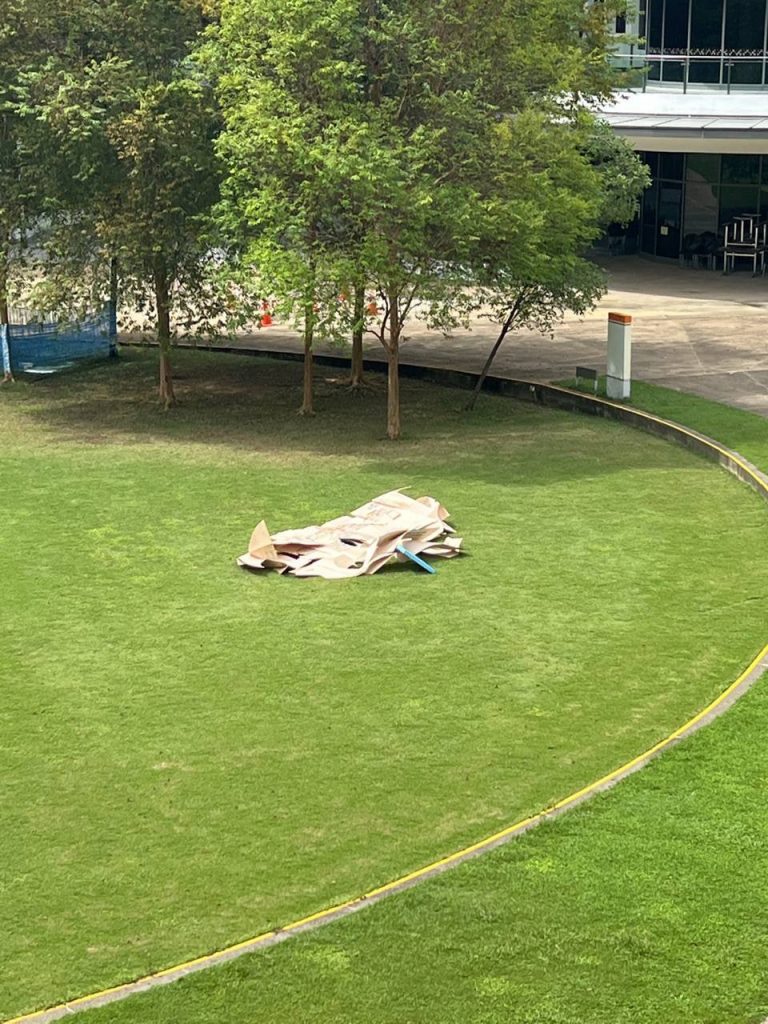
The pièce de résistance of the work.
Despite its structural failure, we decided to leave the remnants on site for the remainder of the week we were allocated to exhibit the intervention. We surmised that the intervention could be transformed into a commentary on the seeming unattainability of happiness. (We were also really busy catching up on other modules we had neglected in the last few days.) In a haze of dejection, we wrote a (contrived and trite) soliloquy for the structure.

Calm down, Shakespeare.
Our hasty attempt at legitimising the pile of rubble was overshadowed by an anonymous member of the public who placed a chair next to the work. Artist Maurizio Cattelan’s 2019 work titled “Comedian” consists of a ripe banana duct taped to a wall, complete with instructions for display and upkeep. Two editions of the piece sold for US$120,000. We had taped the banana to the wall, and this person had supplied the stanchions, artwork label, and documentation.
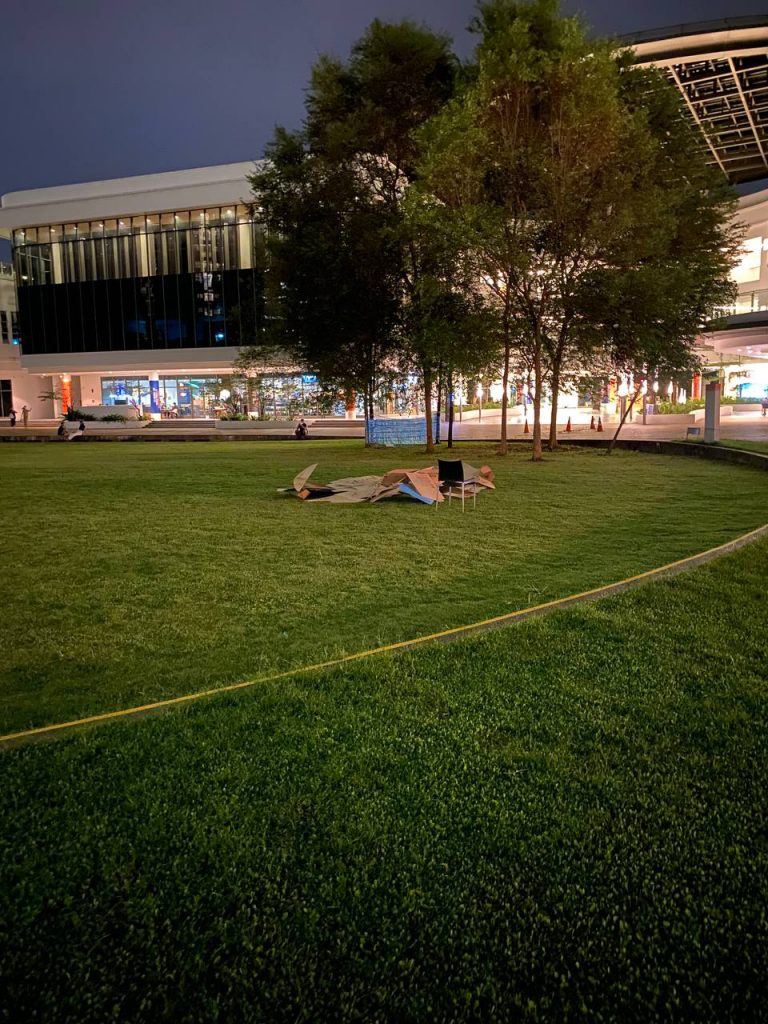
A chair creates affordances for how to view the work. Photographed by Willis Lau.
At the end of the week, we silently moved the rubble off UTown Green at night and returned the chair. I don’t think either Andrew or I can say we were satisfied with how the project unfolded, but a new opportunity presented itself a few months later. While the seminar project was over, it was far from the end of  .
.
In November 2021, the Urban Redevelopment Authority (URA) announced the third iteration of its Spark Challenge, calling for proposals from the public to enliven and activate public commercial spaces. We figured we’d give the competition a shot, and submitted redesigned proposals for sites at Paya Lebar. The redesigns were conceptually the same at their core. We still curated the structures such that the public would be able to find the three symbols from selected spots around Paya Lebar. Because of how site-specific the design was, each site together with its unique selection of three vantage points resulted in vastly different forms. Envisaging the installation in shopping malls provided us opportunities to engage people on different storeys, so we decided to “reward” shoppers on the less-frequented top floor of Singpost Centre for looking down at the atrium.
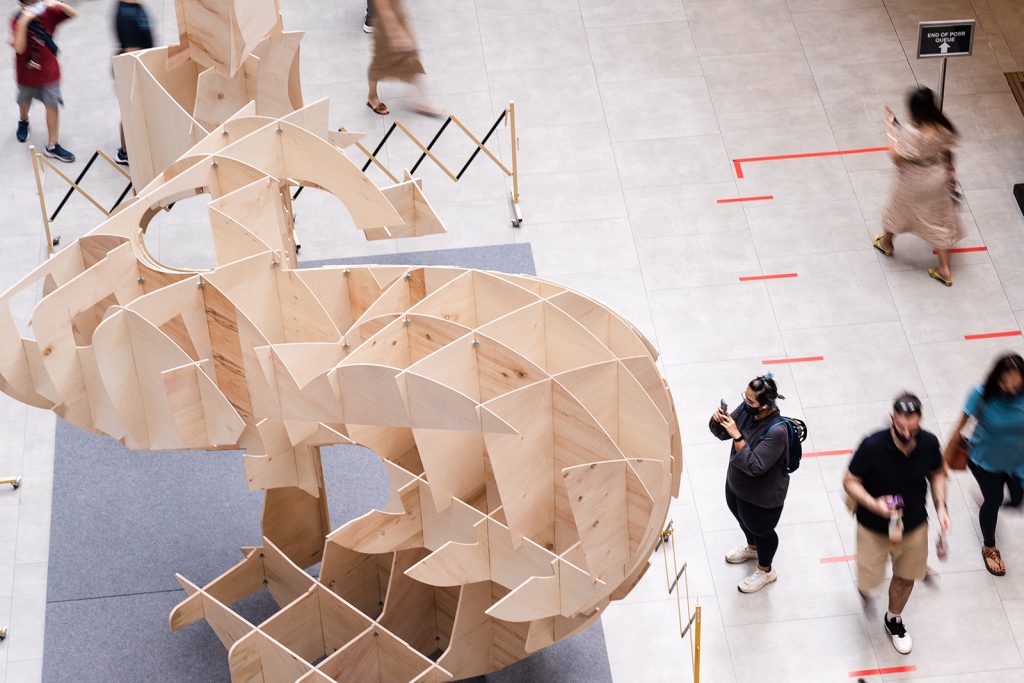
People with ![]() .
.
We figured, apart from drawings, the best way to convey the anamorphic form of our designs was through a physical model the competition panel could hold and rotate with their own hands and eyes to search for the symbols as we talked about them. For some reason, the real estate managers were particularly obsessed with finding the dollar sign in the three proposals.

Posing in the lift in The URA Centre after our presentation.
The panel accepted our proposal as one of the finalists, so we were funded to install an installation at two separate malls. We felt like fish out of water – we were students competing against professionals in building, construction, and design industries. Not to mention, the collapse of the intervention project constantly nagged at the back of our minds. We were working with hundreds of times the budget we had previously, putting up two structures in a more densely populated locale for a month while working with URA and mall managers. This had to go well. Our experience with the UTown intervention, as well as the expertise and support of our contractors thankfully saw us through.
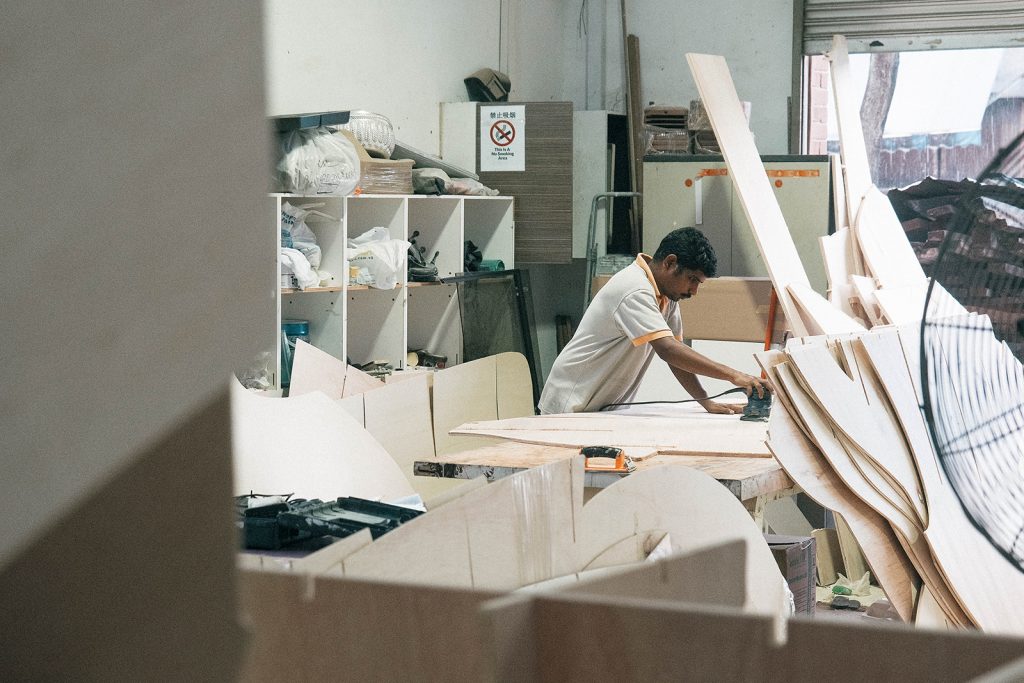
A member of the fabrication team sands down machined pieces.
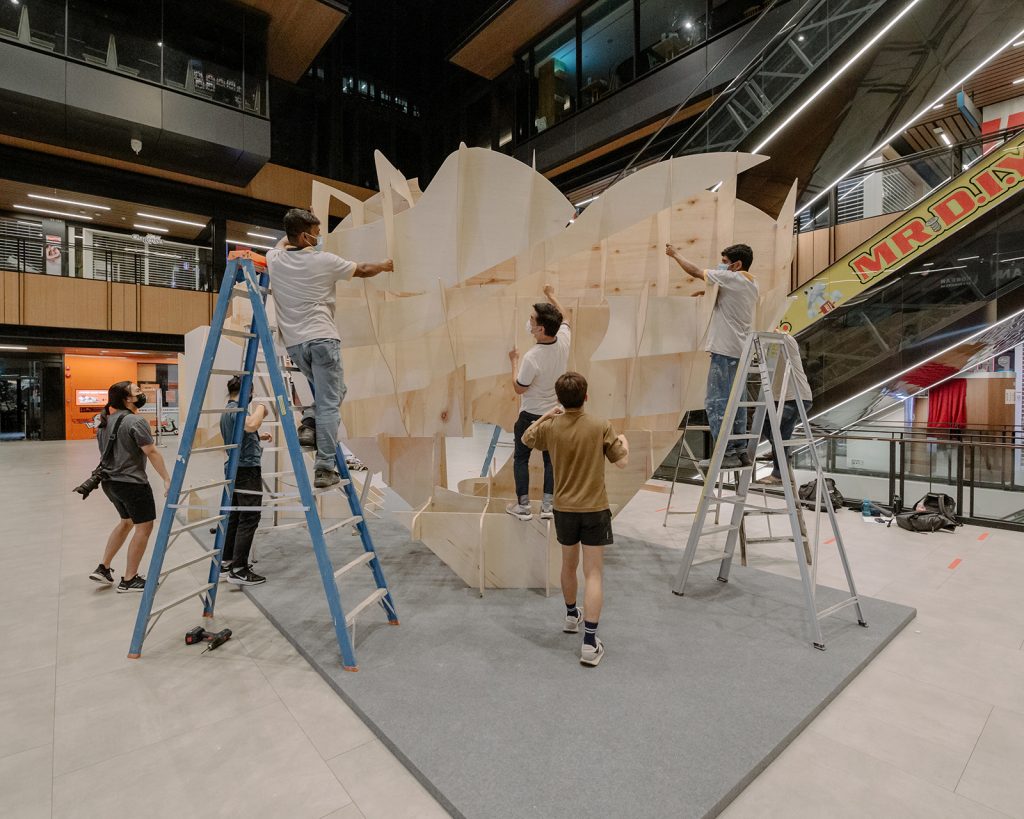
The team aligns the final layer of the installation at Singpost Centre.

The team hoists the structure into place at Paya Lebar Quarter.
We didn’t end up winning the competition – that honour goes to the installation in front of ours in the above photo – but I think we achieved what we set out to do. For a short month earlier this year, we initiated a dialogue with the public on individual and shared aspirations, and I hope we all walked away more cognizant of our pursuit of happiness.
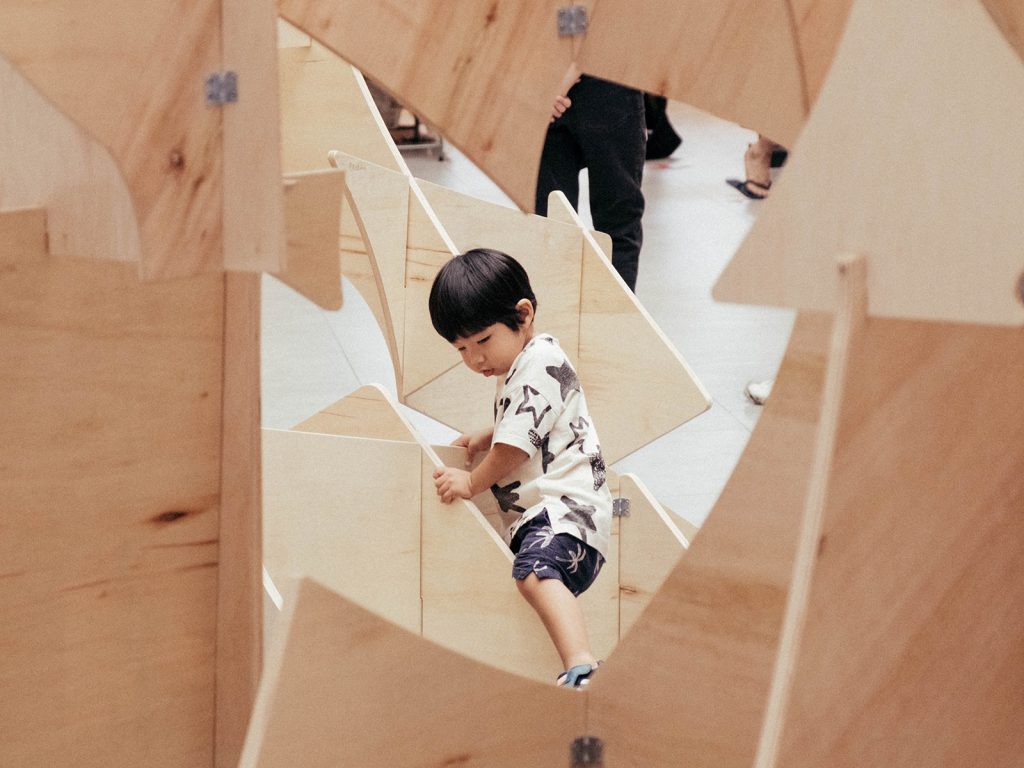
Happiness is exploration.
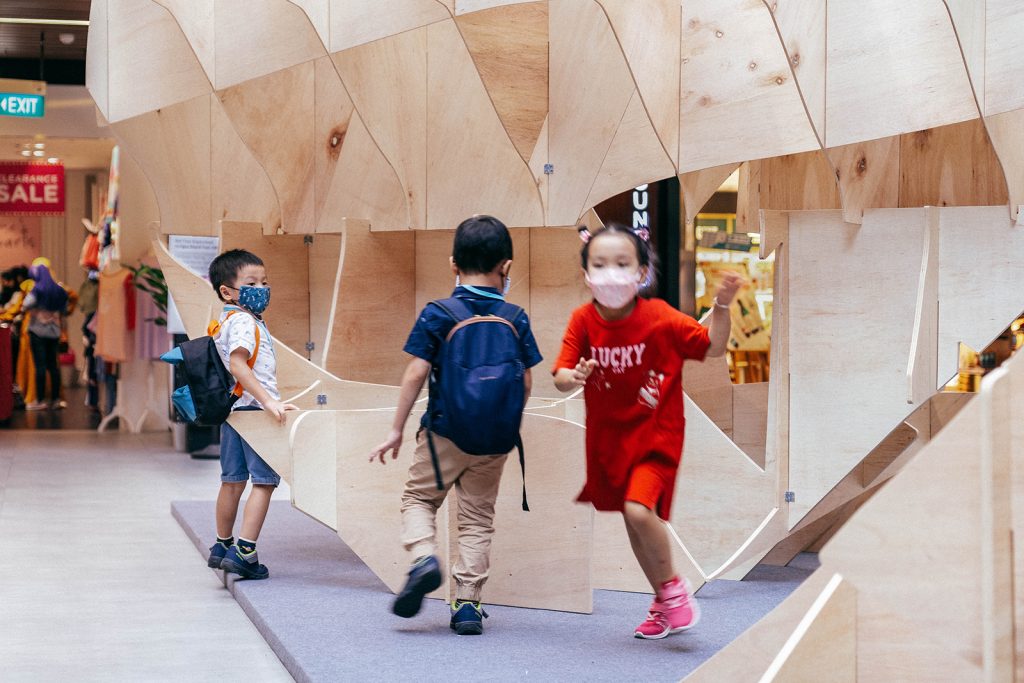
Happiness is play.
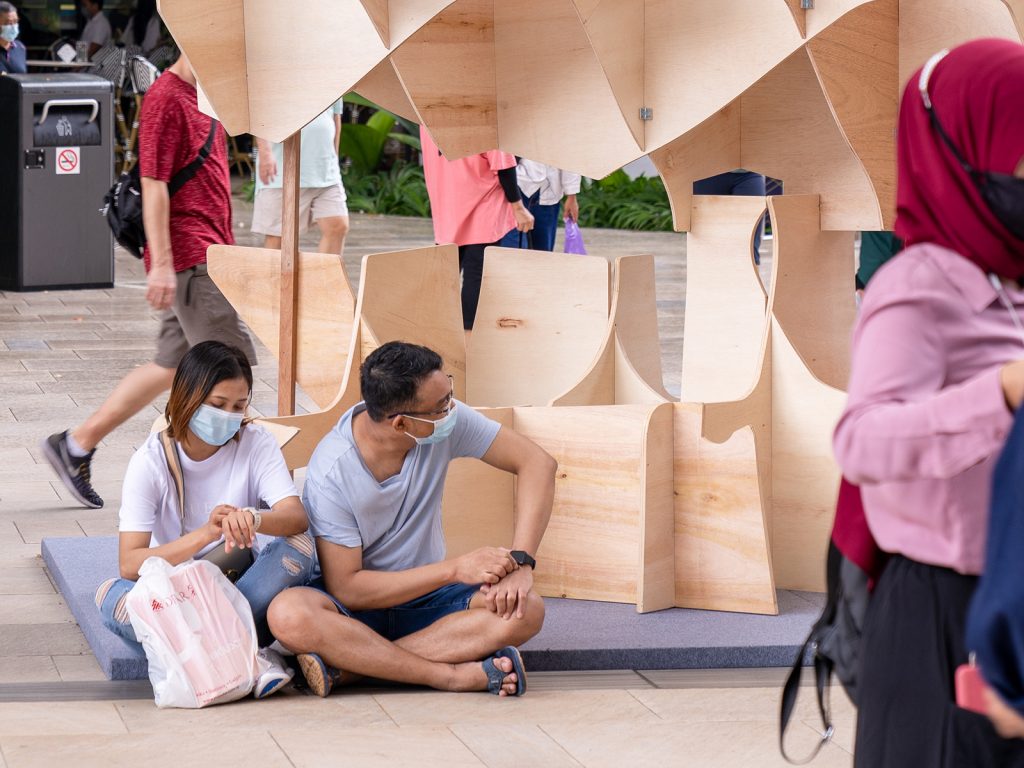
Happiness is somewhere to sit in a retail space.
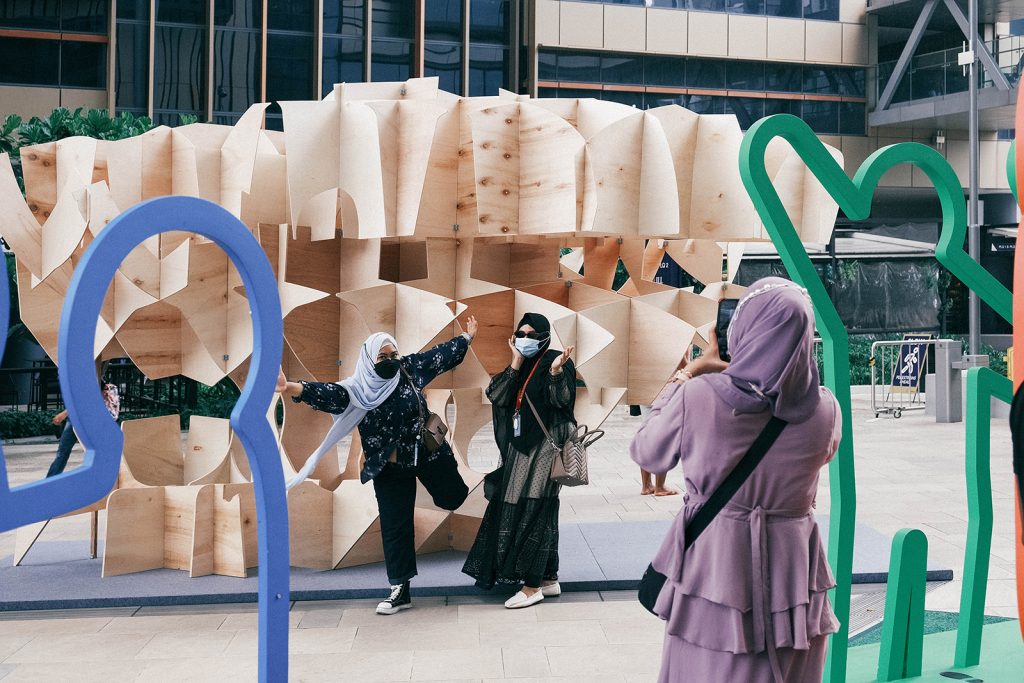
Happiness is the time you spend with friends.
To me, happiness is whatever you make it out to be. I know I had fun on this journey, and who’s to say the public didn’t either?
Header image and all images used in this photo essay are from the author’s and their teammate Andrew’s private collection unless otherwise stated, in which case due credit has been given.
About the author:
Chee Meng is a third-year undergraduate who strongly believes in asking for forgiveness over permission. They are a devout practitioner of the art form of faking it until you make it.
References:
[1] Tan, M. (2021) UTS2105/UTC2105: Singapore as “Model” City? [Syllabus document]. National University of Singapore, UTS2105.






